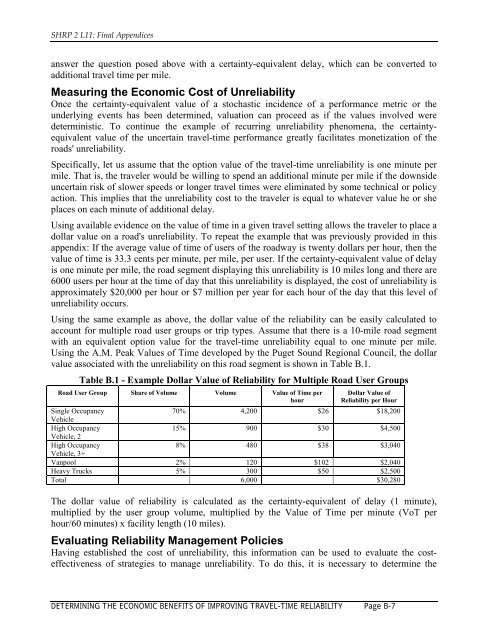Evaluating Alternative Operations Strategies to Improve Travel Time ...
Evaluating Alternative Operations Strategies to Improve Travel Time ...
Evaluating Alternative Operations Strategies to Improve Travel Time ...
You also want an ePaper? Increase the reach of your titles
YUMPU automatically turns print PDFs into web optimized ePapers that Google loves.
SHRP 2 L11: Final Appendices<br />
answer the question posed above with a certainty-equivalent delay, which can be converted <strong>to</strong><br />
additional travel time per mile.<br />
Measuring the Economic Cost of Unreliability<br />
Once the certainty-equivalent value of a s<strong>to</strong>chastic incidence of a performance metric or the<br />
underlying events has been determined, valuation can proceed as if the values involved were<br />
deterministic. To continue the example of recurring unreliability phenomena, the certaintyequivalent<br />
value of the uncertain travel-time performance greatly facilitates monetization of the<br />
roads' unreliability.<br />
Specifically, let us assume that the option value of the travel-time unreliability is one minute per<br />
mile. That is, the traveler would be willing <strong>to</strong> spend an additional minute per mile if the downside<br />
uncertain risk of slower speeds or longer travel times were eliminated by some technical or policy<br />
action. This implies that the unreliability cost <strong>to</strong> the traveler is equal <strong>to</strong> whatever value he or she<br />
places on each minute of additional delay.<br />
Using available evidence on the value of time in a given travel setting allows the traveler <strong>to</strong> place a<br />
dollar value on a road's unreliability. To repeat the example that was previously provided in this<br />
appendix: If the average value of time of users of the roadway is twenty dollars per hour, then the<br />
value of time is 33.3 cents per minute, per mile, per user. If the certainty-equivalent value of delay<br />
is one minute per mile, the road segment displaying this unreliability is 10 miles long and there are<br />
6000 users per hour at the time of day that this unreliability is displayed, the cost of unreliability is<br />
approximately $20,000 per hour or $7 million per year for each hour of the day that this level of<br />
unreliability occurs.<br />
Using the same example as above, the dollar value of the reliability can be easily calculated <strong>to</strong><br />
account for multiple road user groups or trip types. Assume that there is a 10-mile road segment<br />
with an equivalent option value for the travel-time unreliability equal <strong>to</strong> one minute per mile.<br />
Using the A.M. Peak Values of <strong>Time</strong> developed by the Puget Sound Regional Council, the dollar<br />
value associated with the unreliability on this road segment is shown in Table B.1.<br />
Table B.1 - Example Dollar Value of Reliability for Multiple Road User Groups<br />
Road User Group Share of Volume Volume Value of <strong>Time</strong> per<br />
hour<br />
Single Occupancy<br />
Vehicle<br />
High Occupancy<br />
Vehicle, 2<br />
High Occupancy<br />
Dollar Value of<br />
Reliability per Hour<br />
70% 4,200 $26 $18,200<br />
15% 900 $30 $4,500<br />
8% 480 $38 $3,040<br />
Vehicle, 3+<br />
Vanpool 2% 120 $102 $2,040<br />
Heavy Trucks 5% 300 $50 $2,500<br />
Total 6,000 $30,280<br />
The dollar value of reliability is calculated as the certainty-equivalent of delay (1 minute),<br />
multiplied by the user group volume, multiplied by the Value of <strong>Time</strong> per minute (VoT per<br />
hour/60 minutes) x facility length (10 miles).<br />
<strong>Evaluating</strong> Reliability Management Policies<br />
Having established the cost of unreliability, this information can be used <strong>to</strong> evaluate the costeffectiveness<br />
of strategies <strong>to</strong> manage unreliability. To do this, it is necessary <strong>to</strong> determine the<br />
DETERMINING THE ECONOMIC BENEFITS OF IMPROVING TRAVEL-TIME RELIABILITY Page B-7















